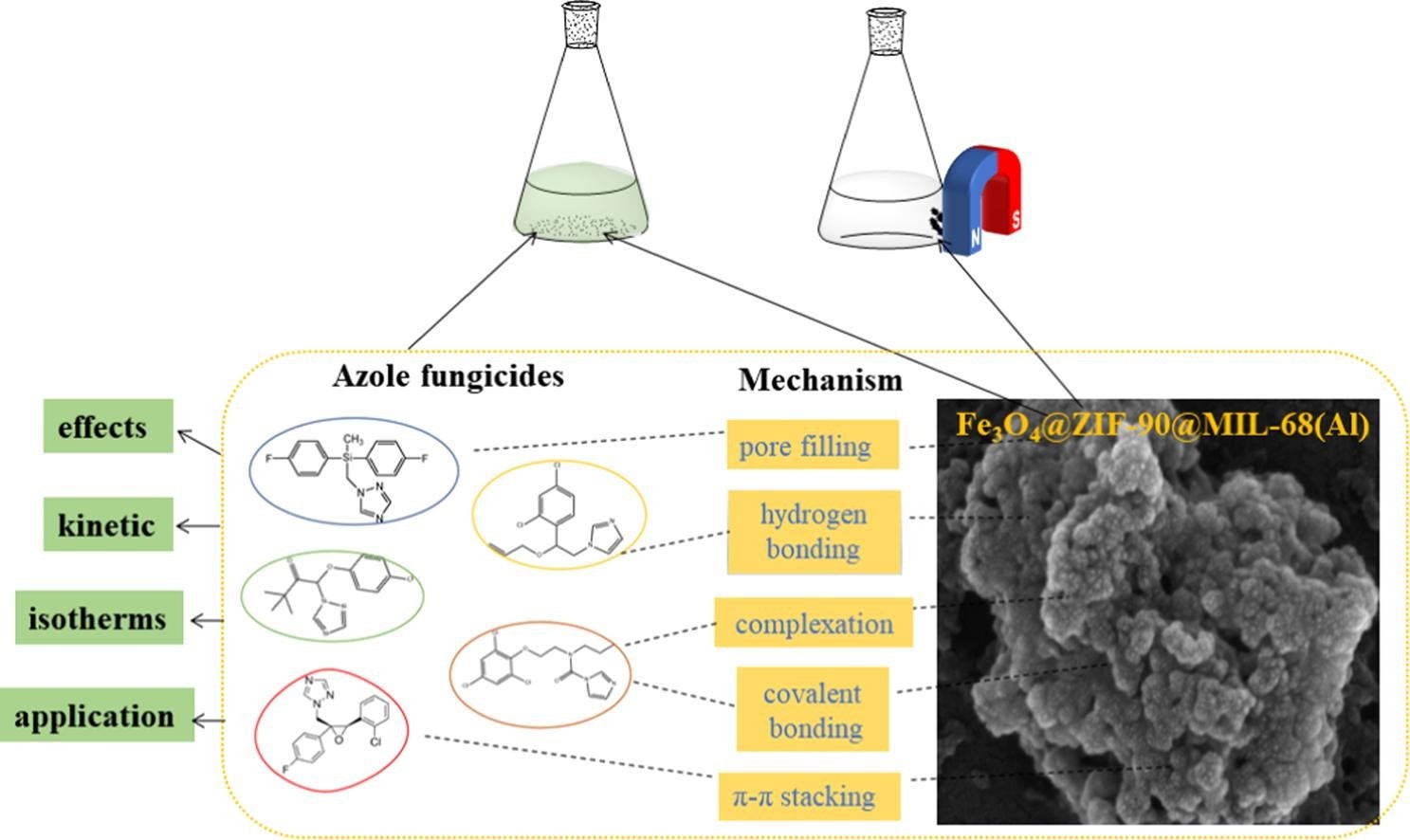南湖新闻网讯(通讯员 杨中华)近日,我校植物科学技术学院李建洪教授团队研究成果以“A novel magnetic double MOF composite is synthesized for removing azole fungicides economically and efficiently”为题在Applied Surface Science上发表。该研究合成了一种新型磁性双MOF吸附材料并围绕该材料建立了稻田生态系统中5种唑类杀菌剂多残留的快速去除方法。

Fe3O4@ZIF-90@MIL-68(Al) 对唑类杀菌剂吸附机理
研究人员通过金属有机框架ZIF-90 和 MIL-68(Al) 合成了一种新型的磁性双MOF复合材料---Fe3O4@ZIF-90@MIL-68(Al),并将其用于稻田生态系统中唑类杀菌剂的残留去除。经FT-IR,TEM,SEM,XRD,VSM,Zeta,BET,TG等一系列表征分析证实,与传统单MOF材料相比,该材料化学性质更稳定,可以快速分散在水环境中,更适合田间实际应用,且对环境中残留的农药具有优良的吸附性能。此外,采用HPLC及FT-IR分析技术考察了其重复利用性,发现在连续十次吸附-解吸循环后,对目标农药的去除效率仍保持较高水平。与其他吸附材料相比,Fe3O4@ZIF-90@MIL-68(Al)在吸附能力和再生能力方面表现出双金属有机框架材料的特有优势。最后,作者应用该吸附材料建立了稻田生态系统中5种唑类杀菌剂多残留的快速去除方法。在实际样本加标实验中,目标农药去除效率均达80 %以上。该研究对稻田生态系统中农药残留净化去除具有重要意义。
研究团队在MOF修饰的生物质复合材料研发中,将小麦秸秆制成生物炭与磁性MOF材料结合,制备了可同时去除唑类杀菌剂残留又兼具较高杀菌活性的新型吸附材料,也为材料的多功能化研究提供了新的思路;在MOF材料与唑类农药吸附机理研究方面,运用molclus等软件结合吸附动力学、吸附热力学及XPS等表征分析技术,从分子模拟、理论计算、表征推断、实际验证等多个层面揭示MOF材料特异性吸附唑类农药的机理,为进一步从分子结构出发,合成特异性吸附剂打下良好基础;在磁性MOF材料基于的MSPE农药残留快检技术研究中,合成了多种唑类农药特异性吸附剂,将MSPE技术与QuEChERS方法联用,扩大MSPE技术的应用范围,简化QuEChERS方法净化过程,对快速检测食品中农药残留具有重要意义。
植物科学技术学院硕士研究生周冬冬为该论文第一作者,杨中华副教授为通讯作者。该研究得到国家重点研发计划项目(2019YFD1002103)湖北省自然科学基金(2020CFB528)和国家自然科学基金资助(21507032)。
审核人:李建洪
【英文摘要】
In this study, Fe3O4@ZIF-90@MIL-68(Al) composite was synthesized by a facile method and used as a reusable adsorbent to effectively remove azole fungicides from paddy field water. Notably, the introduction of ZIF-90 made the magnetic adsorbent more stable and significantly improved the adsorption performance. Specifically, a series of characterization analysis were carried out and this composite displayed a high specific surface area, excellent magnetic strength, and good thermal stability, which meet the expectations. Additionally, the adsorption behaviors and mechanisms of Fe3O4@ZIF-90@MIL-68(Al) toward azole fungicides were studied systematically. The pseudo-second-order kinetic model and Langmuir isotherm model was confirmed to be more suitable for describing this adsorption process. Besides, the adsorption process of azole fungicides onto Fe3O4@ZIF-90@MIL-68(Al) was mainly based on pore filling, surface complexation, covalent bonding, π-π stacking effect and hydrogen bonding. Interestingly, the maximum adsorption capacity of Fe3O4@ZIF-90@MIL-68(Al) toward prochloraz was 352.32 mg g−1, which was probably one of the highest adsorption capacities reported. Meanwhile, the magnetic adsorbent can be regenerated by methanol treatment and maintain a high adsorption capacity after the 10th cycle. Hence, this work provides an economical and feasible method for removing azole fungicides from field water samples.

